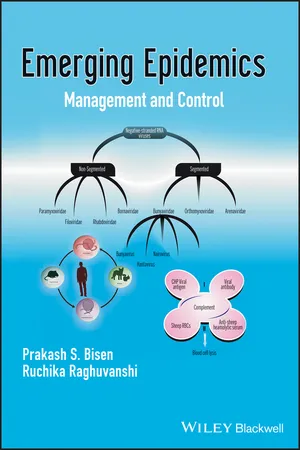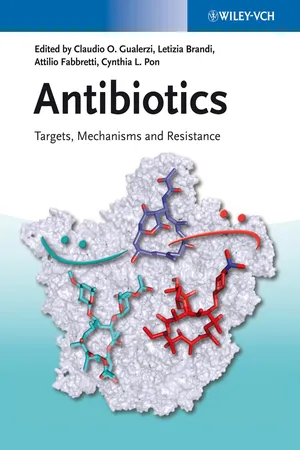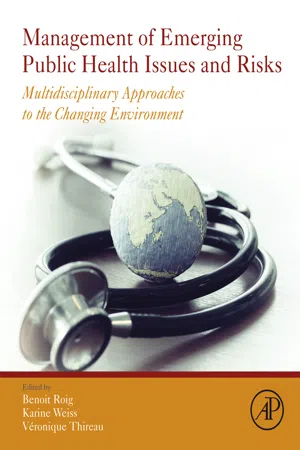Biological Sciences
Antibiotic Resistant Bacteria
Antibiotic resistant bacteria are strains of bacteria that have developed the ability to withstand the effects of antibiotics, making these medications ineffective in treating infections caused by these bacteria. This resistance can occur through genetic mutations or the acquisition of resistance genes from other bacteria. Antibiotic resistant bacteria pose a significant public health threat, as they can lead to more difficult-to-treat infections and increased healthcare costs.
Written by Perlego with AI-assistance
Related key terms
4 Key excerpts on "Antibiotic Resistant Bacteria"
- eBook - ePub
Emerging Epidemics
Management and Control
- Prakash S. Bisen, Ruchika Raghuvanshi(Authors)
- 2013(Publication Date)
- Wiley-Blackwell(Publisher)
Chapter 21
Antimicrobial Resistance
Introduction
Antibiotics have revolutionized how patients with bacterial infections are treated; they have further contributed to reducing the mortality and morbidity from bacterial diseases. They are also an essential tool for modern medicine and several surgical procedures, such as transplantation, chemotherapy for cancer, and even the orthopaedic surgery, could not be performed without the administration of potent antibiotics. Antibiotic resistance is currently the greatest challenge to the effective treatment of infectious diseases globally. It is a type of resistance in which a microorganism is able to survive exposure to a specific antibiotic. The drug resistance can be acquired by a spontaneous or induced genetic mutation in bacteria. Genes conferring drug resistance can be transferred between bacteria horizontally by any of the methods of genetic recombination, including conjugation, transduction, or transformation. Thereby, a gene for antibiotic resistance, which had evolved via natural selection, may be shared, and an evolutionary stress, such as exposure to antibiotics, then selects for the antibiotic resistant trait. Most of the antibiotic resistance genes reside on plasmids (an extra chromosomal material), facilitating their easy transfer. In case a bacterium carries several resistance genes against different antibiotics, it is called multidrug resistant (MDR), or informally, a superbug or superbacterium.Genes for resistance to antibiotic drugs, like the antibiotics themselves, are ancient (D’Costa et al., 2011). However, the increasing prevalence of drug-resistant bacterial infections commonly observed in clinical practice stems from antibiotic use both within human medicine and veterinary medicine. The use of antibiotics can increase selective pressure in a population of bacteria and allow the resistant bacteria to thrive and the susceptible bacteria to die off. As resistance toward antibiotics becomes more common, there arises a greater need for alternative treatments. However, despite a discovery of new antibiotic therapies, there has been a continued decline in the number of newly approved drugs (Donadio et al., 2010). Antibiotic resistance poses a significant problem, and it is also important to understand international patterns of resistance with globalization booming. The excessive use of antibiotics both inside and outside of medicine is playing a significant role in the emergence of resistant bacteria. Although initially there were few pre-existing antibiotic-resistant bacteria before the widespread use of antibiotics, evolutionary pressure from their use has played a role in the development of multidrug resistance varieties and the spread of resistance against more than one drug between bacterial species. - eBook - ePub
Antibiotics
Targets, Mechanisms and Resistance
- Claudio O. Gualerzi, Letizia Brandi, Attilio Fabbretti, Cynthia L. Pon(Authors)
- 2013(Publication Date)
- Wiley-VCH(Publisher)
Chapter 4
Antibiotics and Resistance: A Fatal Attraction
Giuseppe Gallo and Anna Maria Puglia4.1 To Be or Not to Be Resistant: Why and How Antibiotic Resistance Mechanisms Develop and Spread among Bacteria
The continual battle between humans and the multitude of microorganisms that cause infections and diseases has caused significant morbidity and mortality throughout history. The situation significantly improved when penicillin and other classes of antibiotics were discovered and used to treat infectious diseases. However, almost as soon as antibacterial drugs were introduced in clinics, bacterial resistance spread [1, 2].Antibiotic resistance can be defined taking into account the pharmacokinetic and pharmacodynamic criteria to determine values above which a therapeutically useful concentration is difficult to obtain. If the minimal inhibitory concentration (MIC) for a bacterium is above those concentration values, a risk exists that the infection cannot be successfully treated. Therefore, the microorganisms are classified as resistant when their MICs are above a predefined threshold.Bacterial resistance is a concern for several reasons. From a medical, social, and economical viewpoint, resistant bacteria, becoming commonplace in healthcare institutions, often result in treatment failure and this implies an added burden on healthcare costs [3]. In addition, resistant bacteria may also spread and become broader infection-control problems, not only within healthcare institutions but in communities as well [4, 5]. From a biological and microbiological viewpoint, antibacterial drug resistance is a fascinating aspect of molecular evolution and selection of fine mechanisms that allow survival under unfavorable circumstances. In particular, under the selective pressure of antibiotics, bacteria evolve and spread resistance mechanisms that become common to pathogenic and nonpathogenic strains. To fully understand the evolution of resistance, the maintenance of resistance genes within microbial populations and the spread of these genes between species and genera, the concept of “resistome” was introduced [6]. The resistome includes the totality of those genetic elements whose function is to counteract toxic effects of antibiotic drugs. Furthermore, the resistome also comprises the collection of genes, calledprotoresistance genes - eBook - ePub
The Microbes Fight Back
Antibiotic Resistance
- Laura Bowater(Author)
- 2017(Publication Date)
- Royal Society of Chemistry(Publisher)
CHAPTER 5 What is Antibiotic Resistance?5.1 Antibiotics Defined
There is no doubt that the discovery of antibiotics has changed our modern lives. Antibiotics first captured the attention of scientists and doctors because of their intrinsic, natural ability to harm or destroy bacteria. Selman Waksman was the first scientist to use the term “antibiotic” to describe the suite of small molecules synthesised by microbes that inhibit the growth of others. In 1941, according to Waksman, an antibiotic was:“a chemical substance of microbial origin that possesses antibiotic powers” .†Ever since their mass production, society has been exploiting the distinctive chemical properties of these life-changing microbial substances to combat infection. The huge potential offered by these new drugs encouraged scientists to explore the chemistry wrapped up in antibiotics. As the chemical structure started to emerge, scientists began to exploit this information to chemically tweak these natural products to create semisynthetic antibiotics, like the cephalosporins. But scientists didn't stop at chemical tweaking. Brand new, clinically relevant synthetic drugs with antimicrobial properties, such as nalidixic acid and ciprofloxacin, were designed and synthesised. Waksman's original definition of an antibiotic was no longer fit for purpose. A new era had emerged; antibiotics were not just natural products produced by microbes. A newer, more encompassing definition of an antibiotic was needed to take account of human inventiveness. These days, antibiotics are defined quite simply as an agent, a drug or a medication that either inhibits the growth of or destroys microorganisms, including bacteria.5.2 Antibiotics Up Close and Personal
The natural chemical structures of microbe-made antibiotics are quite intriguing. They are quirky molecules with only a passing resemblance to the conventional biochemical building blocks of a living cell. They are not the amino acids building blocks that combine in proteins or the lipid molecules that line up in cell membranes or the simple sugars needed for cellular metabolism. Neither are they the nucleic acids used to synthesise DNA and RNA. Instead, antibiotics fall into distinct structural families that share unique properties. The synthesis of each natural antibiotic requires a suite of enzymes that work together to produce a finished product. And each suite of enzymes required by the microbe to synthesise the antibiotic needs a matching set of designer genes. Every naturally produced antibiotic is formed on a production line that uses individual enzymes to catalyse each step. Synthesising antibiotics requires significant investment from the microbe in question.1 - eBook - ePub
Management of Emerging Public Health Issues and Risks
Multidisciplinary Approaches to the Changing Environment
- Benoit Roig, Karine Weiss, Veronique Thireau, Benoit Roig, Karine Weiss, Veronique Thireau(Authors)
- 2018(Publication Date)
- Academic Press(Publisher)
Part 3 Known Issues Now Recognized as Risks Due to an Increase in Scientific Knowledge and/or a Change in the Perception of the PopulationOutline- Chapter 7. Antimicrobial Resistant Genes and Organisms as Environmental Contaminants of Emerging Concern: Addressing Global Public Health Risks
- Chapter 8. Risk Perception of Pharmaceutical Residues in the Aquatic Environment and Precautionary Measures
- Chapter 9. Chemistry and Psychology: Cross Views on Pesticide Risks
- Chapter 10. Assessment and Management of Risks Associated With Antibiotic Resistance in the Environment
Passage contains an image
Chapter 7Antimicrobial Resistant Genes and Organisms as Environmental Contaminants of Emerging Concern: Addressing Global Public Health Risks
Haley Sanderson1 , R. Stephen Brown1 , 2 , Patricia Hania3 , Tim A. McAllister4 , Anna Majury1 , 5 , and Steven N. Liss1 , 61 School of Environmental Studies, Queen's University, Kingston, ON, Canada2 Department of Chemistry, Queen's University, Kingston, ON, Canada3 Department of Law and Business Management, Ted Rogers School of Management, Ryerson University, Toronto, ON, Canada4 Lethbridge Research and Development Centre, Agriculture and Agri-Food Canada, Lethbridge, AB, Canada5 Public Health Ontario, Kingston, ON, Canada6 Department of Chemistry and Biology, Ryerson University, Toronto, ON, CanadaAbstract
Antimicrobial agents are an essential part of the global health care system. Antimicrobial resistance (AMR) threatens their utility and is an ever-growing public health problem. The “One Health” approach is a cornerstone of public health and involves including human, animal, and environmental health into the analysis of the problem and into proposed solutions at local, national, and global scales. However, environmental health has been overlooked in the action plans, policies, and regulations used to address AMR. This chapter discusses the current research related to environmental AMR and the challenges related to risk assessment, surveillance, and incorporating environmental AMR into existing legal frameworks, regulations, public health actions plans, and global partnerships that aim to combat AMR.
Learn about this page
Index pages curate the most relevant extracts from our library of academic textbooks. They’ve been created using an in-house natural language model (NLM), each adding context and meaning to key research topics.



